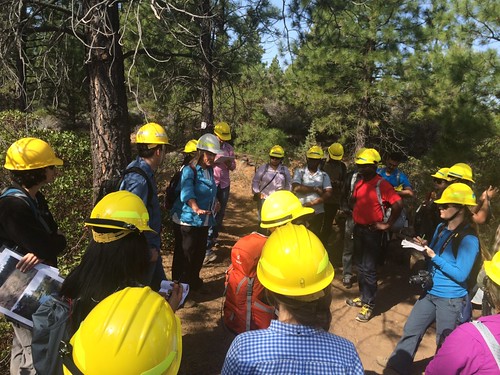
Participants of the International Seminar on Forest Landscape Restoration on a field trip. Photo credit: US Forest Service
This blog post was co-authored with Aaron Reuben (International Union for Conservation of Nature) and Kathleen Buckingham (World Resources Institute).
Four billion acres of degraded and deforested land world-wide—an area the size of South America—are in need of restoration. Restoration addresses our most pressing global challenges—from protecting biodiversity to providing food, energy and water, to offering security and economic opportunity for millions of people.
In the United States, a multitude of partners from all sectors, from the local to national level, initiated restoration on millions of acres of degraded land, but the United States cannot do it alone. Degradation is a global issue that requires a global response. This summer, landscape restoration professionals from 16 countries, representing government ministries, non-governmental organizations and private companies, gathered in Oregon to learn from the United States’ experience.
The U.S. Forest Service’s International Programs’ International Seminar on Forest Landscape Restoration brought together practitioners from Armenia, Brazil, Guatemala, Honduras, Indonesia, Israel, Malawi, Rwanda, Turkey and Zambia, among many other countries, for a three-week shared learning event. Through technical presentations, exercises and field visits to restoration sites across the state of Oregon (including in the Mt. Hood National Forest, the Deschutes National Forest, and the Malheur National Forest) participants learned the full variety of techniques for restoration employed in the western United States. The seminar covered topics such as restoration planning and opportunity assessment, technical implementation and stewardship. Restoration activities in the field included thinning and burning to restore natural forest structures, use of native seeds and plants and river and meadow restoration. Additionally, the history of conflict, collaboration and scientific achievement that marks the advancement of forest management and restoration in the United States was shared as important context with participants.
The seminar also allowed participants to share their own experience in forest landscape restoration and identify common opportunities and constraints. Many seminar sessions focused on developing leadership skills to help the practitioners move restoration forward in their home countries. Some participants committed to join with members of their cohort working in nearby countries to build expertise in their region. All were heartened to join the growing global network of restoration professionals. “I hope this spirit of teamwork will continue to hold us together,” said Samuel Kofi Nyame, a Project Coordinator for the International Union for Conservation of Nature in Ghana. “We can continue to learn from one another and be an inspiration to those to yet come.”
Some key lessons emerged from the seminar:
Restoration comes in many forms. Understanding the limiting factors for restoration is a key element that is relevant to all landscapes globally. In Oregon, a history of fire suppression has led to overstocking in many of the state’s forests, increasing the threat of a catastrophic wildfire in a landscape that has historically been adapted to frequent, less-severe fires. In order to protect water resources and promote more fire-resilient landscapes, experts conduct restoration interventions—such as thinning and prescribed fire. This approach seemed counterintuitive at first to participants who come from landscapes with different limiting factors and restoration needs—primarily bringing back trees and vegetation to degraded areas.
To go fast, go alone. To go far, go together. Effective forest landscape restoration integrates different uses and needs from the land for multiple long-term objectives. While participatory approaches allow for effective prioritizing, planning, implementing and monitoring successes, balancing different needs can be challenging—especially in areas with a history of contention. After years of gridlock over differing priorities, diverse forest users in Oregon, like the members of the Southern Blues Restoration Coalition, are now working towards common goals together. Through conversations with collaborative members, seminar participants learned that building community relationships is possible and critical. Hanqian (Sophie) Zhang, Water Resources Protection Manager for Danone Waters in China, was particularly impressed with the history of collaboration in forest management in the United States. “I have taken to heart that one should always keep the spirit of collaboration going in order to achieve something greater,” Zhang shared.
It’s all connected. Another key takeaway of the seminar centered on the connections between ecological, social and economic contexts and objectives. Sandeep Kandicuppa with the Foundation for Ecological Security in India observed that, as forest landscape restoration professionals, “we must work with others to find the interconnections” between different land uses and across land ownership boundaries. For his home landscape and many others, local communities rely on forest products for food and fiber. To Kandicuppa, restoration that does not consider economic development and alternative livelihoods will not be successful.
The seminar concluded on a rainy day in Portland, with presentations of forest landscape restoration action plans developed by each participant for use in their home landscape. Mary Wagner, Associate Chief of the U.S. Forest Service, was on hand for the final presentations. Given the urgency of the task facing land managers around the world, who need restored and resilient landscapes to meet the demands of the next generation, “it can be easy to get overwhelmed,” she told her international audience. Addressing the gathered professionals, members of a new community of practice spanning 16 countries, she smiled, “Isn’t it nice to know that we don’t have to do this alone?”
The International Seminar on Forest Landscape Restoration was co-hosted by the U.S. Forest Service, the International Union for Conservation of Nature, and the World Resources Institute. To learn more about the different US Forest Service seminars and next year’s schedule, visit: http://www.fs.fed.us/about-agency/international-programs/training-seminars.
This post is part of a series featuring the Forest Service’s work on restoration across the country.
No comments:
Post a Comment
Note: Only a member of this blog may post a comment.